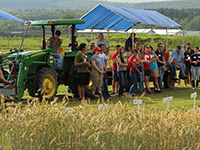 Skill Level
Skill Level
Beginner, Intermediate, Advanced
Learner Outcomes
- Explore how inner thoughts and beliefs align with outer actions.
- Make a simple goal for action to work towards a community food system of which you want to be part.
Life Skills
Learning to learn, decision-making, problem solving, critical thinking, service learning, goal setting, planning/organizing, keeping records, resiliency, communications, sharing, leadership, marketable/useful skills, self-motivation, self-esteem, self-responsibility, character
Time
20 minutes
Materials
- Long and narrow strip of paper for each youth
- Pencils or pens for each youth
- Index card for each youth to draw or write out their commitment
Space
Comfortable place for youth to reflect with writing surface available and whole group discussion
Introduction
In this activity, youth will explore how their inner beliefs can inform their outer actions. They will reflect on what is important to them. It is our intention to center on young people’s gifts and to ultimately have each person determine a simple commitment they can make to work towards a community and food system of which they want to be part.
Share with youth that it is common to feel anxiety when we try to do too much – and indeed, it has become a Western cultural problem, with a lot of people feeling stressed out, and worried that no matter how much they do, it isn’t enough. We hope to show youth the importance of understanding our limits and that we do not have to do it all to make a difference. In addition, when we do engage in activity, it is often so much more enjoyable when it is informed by our strengths, gifts, and interests – and we’re more likely to follow through, too.
To support this activity, there is a video “Mobius Strip Exercise” where the steps of creating a mobius strip are demonstrated.
Vocabulary
Mobius strip: an infinite loop, a one-sided surface with only one edge. It can be easily created by attaching the ends of a long, narrow strip of paper together after giving one of the ends a one-half twist. See example photo.
Before the Activity
As the facilitator, it can be helpful to reflect upon your inside beliefs and outside actions. It can be helpful to do the activity for yourself and think about what examples you can offer your group.
Activity
Opening Questions
Choose questions suitable for the group, if appropriate poise the question to set the tone and do not seek an answer.
- What brings you joy?
- What is important to you?
- What are your gifts?
Experience
- Hand out a strip of paper to each person, have them write on one side of the paper “inside” and on the other side of the paper write “outside.”
- Share with group this is an exercise in personal reflection, what they write down or draw is private. Nothing has to be shared unless they want to share it.
- On the “inside” side, have each person write down or draw things that they believe are their biggest gifts, things they are good at, and values that are important to them. This could include ideas, values, beliefs, hopes, dreams, talents, and hobbies. If appropriate, you might offer an example of one of your own – something they might not know about you that you have on the inside.
- On the “outside” side, have each person write and/or draw roles and responsibilities they have in school, at home, and at work. These could include how they believe others may perceive them, their image, their influence, their outward identity, and their impact. Again, you may want to share an example of some of the roles you play on the outside.
- After the group has had enough time to reflect and write, bring the group back together. Hold up a strip of paper and bring the ends together to form a circle. Share that many people spend their entire lives living like this: keeping their beliefs and values on the inside separate from the way they live on the outside.
- Now twist one end of the paper and bring the ends together to form a mobius strip. Share that a more harmonious and consistent way of living could be using our inner thoughts and beliefs to inform our outer actions, and reflecting on our outer actions to see whether or not they are consistent with what is important to us on the inside.
- Ask youth to make a simple commitment. Based on what is important to them on the inside, what can they do to work towards a community and food system they want to be a part of. Emphasize this should be a simple and realistic commitment. Share with youth that it is common to feel anxiety when we try to do too much. We hope to show youth the importance of understanding our limits, and that we do not have to do it all to make a difference. Provide examples that connect the inner to the outer. If family is important to them, perhaps they can cook a meal for their family using local ingredients. If eating healthy is important to them, perhaps they could hang a poster on healthy eating up at their school. Here are some other examples of simple and realistic commitments:
•I will compost my food waste.
•I will use a reusable water bottle instead of buying bottled water.
•I will not eat fast food from a big corporate chain for 30 days.
•I will eat only vegetarian (no meat or fish) 1 day a week.
•I will learn where my nearest farmer’s market or farm stand is and buy my fruits and vegetables there instead of at the supermarket at least twice a month (or ask my parents to do that).
•I will learn to cook a new dish from my culture and share it with family or friends.
•I will volunteer at a local food bank or food pantry once a month. - Handout index cards and have youth write or draw their commitment.
- Have youth gather in a circle, invite each person to take turns sharing their commitment with the group.
- If feasible for your group, have a discussion on accountability. Ask the group, how can we be held accountable for our commitments? For example, you can revisit these commitments at your monthly meetings and check in on progress.
Reflection questions
- What does the mobius strip make you think of?
- How did thinking of commitments feel? Is your commitment realistic?
- Beyond the garden, what other areas of your life could this apply to?
Learn More
- Center for Courage & Renewal
- Hunger and Malnutrition Toolkit Project Ideas Learning to Give
- Take it Home activity containing project and commitment ideas Soul Fire Farm
Acknowledgements
The use of the mobius strip as tool for examining the interconnections between our inner and outer lives was developed by Parker Palmer and is widely used by Circle of Trust® facilitators prepared by the Center for Courage & Renewal.
Part of this activity, creating a commitment, has been adapted from The Big Commitment activity in Youth Grow from Cornell Garden-Based Learning.










